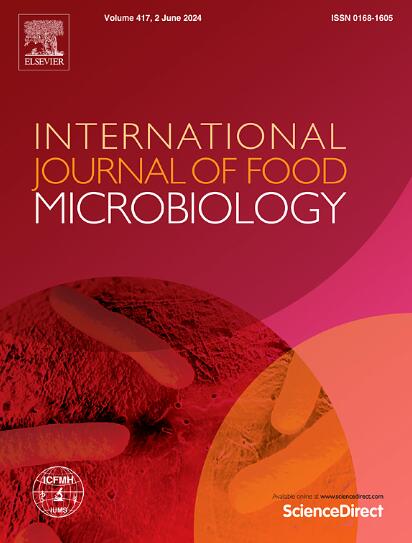The deletion of the uvrY in Aeromonas veronii disrupted the BarA/UvrY two-component system, decreasing persister formation and bacterial resistance to multiple antibiotics
IF 5.2
1区 农林科学
Q1 FOOD SCIENCE & TECHNOLOGY
International journal of food microbiology
Pub Date : 2025-03-28
DOI:10.1016/j.ijfoodmicro.2025.111183
引用次数: 0
Abstract
Antibiotic resistance (AR) is increasingly recognized as a critical global public health threat. Aeromonas species, widely distributed in aquatic environments, have emerged as potential foodborne pathogens. These bacteria are frequently detected in water sources and various ready-to-eat foods, posing a significant risk to food safety and human health. Two-component systems (TCSs) are key regulators of stress tolerance and adaptive behaviors, but the role of the BarA-UvrY TCS in AR is unclear. In our study, multidrug-resistant Aeromonas veronii (A. veronii) strains isolated from the grass carp intestinal contents were used to investigate the role of uvrY in AR, and mutant strain (Δ uvrY) was constructed using homologous recombination. The growth characteristics of wild-type (WT), Δ uvrY, and complemented strains (C-Δ uvrY) were evaluated under various stress conditions. Additionally, prokaryotic transcriptome analysis was performed to identify the downstream stress-factors in WT and Δ uvrY. The results indicated that the Δ uvrY strain exhibited reduced tolerance to osmotic and acid - base stress compared with the WT and C-Δ uvrY. Furthermore, the deletion of uvrY in A. veronii significantly impaired persister formation and decreased resistance to multiple antibiotics, particularly tetracyclines and chloramphenicol. The transcriptome analysis revealed that the increased susceptibility of Δ uvrY to tetracyclines was accompanied by a significant down-regulation of efflux pump genes and NADH dehydrogenase I. STRING network analysis further demonstrated that the BarA-UvrY TCS is associated with genes encoding NADH dehydrogenase I and efflux pump. Additionally, efflux experiments and respiratory rate assays confirmed that the Δ uvrY strain exhibited reduced efflux pump activity and a low respiratory rate, establishing a clear correlation between these two processes. Collectively, BarA-UvrY TCS play a crucial role in AR and persister formation by mediating energy-dependent efflux mechanisms. This study provides mechanistic insights into the regulatory functions of UvrY and offers a theoretical foundation for developing novel strategies to control A. veronii infections and enhance antimicrobial interventions.
维罗氏气单胞菌中uvrY的缺失破坏了BarA/ uvrY双组分系统,降低了持久性形成和细菌对多种抗生素的耐药性
抗生素耐药性(AR)日益被认为是一个严重的全球公共卫生威胁。气单胞菌广泛分布于水生环境中,已成为潜在的食源性病原体。这些细菌经常在水源和各种即食食品中被检测到,对食品安全和人类健康构成重大风险。双组分系统(TCS)是应激耐受性和适应性行为的关键调节因子,但bara - uvery TCS在AR中的作用尚不清楚。本研究利用从草鱼肠内容物中分离的耐多药维罗尼气单胞菌(A. veronii)研究uvrY在AR中的作用,并采用同源重组构建突变菌株Δ uvrY。对野生型(WT)、Δ uvrY和补体菌株(C-Δ uvrY)在不同胁迫条件下的生长特性进行了评价。此外,进行原核转录组分析以确定WT和Δ uvery的下游应激因子。结果表明,与WT和C-Δ uvrY相比,Δ uvrY菌株对渗透和酸碱胁迫的耐受性降低。此外,维罗氏单胞杆菌中uvrY的缺失显著损害了持久性形成,降低了对多种抗生素的耐药性,尤其是四环素和氯霉素。转录组分析显示Δ uvrY对四环素易感性的增加伴随着外排泵基因和NADH脱氢酶I的显著下调。STRING网络分析进一步证实BarA-UvrY TCS与编码NADH脱氢酶I和外排泵的基因相关。此外,外排实验和呼吸频率分析证实Δ uvery菌株表现出外排泵活性降低和呼吸频率低,这两个过程之间建立了明确的相关性。总的来说,BarA-UvrY TCS通过介导能量依赖的外排机制在AR和持久性形成中发挥关键作用。该研究为深入了解UvrY的调控功能提供了机制,并为开发控制维罗氏单胞杆菌感染的新策略和加强抗菌干预提供了理论基础。
本文章由计算机程序翻译,如有差异,请以英文原文为准。
求助全文
约1分钟内获得全文
求助全文
来源期刊
CiteScore
10.40
自引率
5.60%
发文量
322
审稿时长
65 days
期刊介绍:
The International Journal of Food Microbiology publishes papers dealing with all aspects of food microbiology. Articles must present information that is novel, has high impact and interest, and is of high scientific quality. They should provide scientific or technological advancement in the specific field of interest of the journal and enhance its strong international reputation. Preliminary or confirmatory results as well as contributions not strictly related to food microbiology will not be considered for publication.

 求助内容:
求助内容: 应助结果提醒方式:
应助结果提醒方式:


